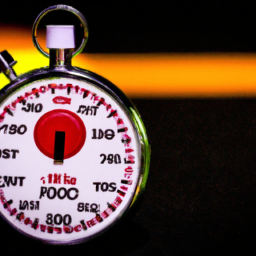If you’re looking to maximize your fat burning potential and transform your workouts, then high-intensity interval training (HIIT) may be the answer you’ve been searching for. HIIT is a powerful and efficient workout method that alternates between short bursts of intense exercise and brief recovery periods. By pushing your body to its limits and challenging your cardiovascular system, HIIT can help you burn more calories both during and after your workout. In this article, we’ll explore the benefits of HIIT and provide you with tips on how to incorporate it into your fitness routine for maximum fat-burning results. Say goodbye to endless hours on the treadmill and hello to a more effective and time-efficient workout!
Table of Contents
ToggleMaximize Fat Burning with High-Intensity Interval Training
What is High-Intensity Interval Training (HIIT)?
High-Intensity Interval Training (HIIT) is a form of exercise that involves short bursts of intense activity followed by brief periods of rest or low-intensity activity. This type of training is designed to increase heart rate and burn a significant amount of calories in a short amount of time. HIIT workouts typically last anywhere from 10 to 30 minutes and can be tailored to fit individual fitness levels and goals.
Benefits of High-Intensity Interval Training
HIIT offers numerous benefits beyond just burning fat. One of the main advantages of this type of training is its efficiency. Since HIIT workouts are shorter in duration compared to traditional cardio exercises, they can easily be incorporated into a busy schedule. Additionally, HIIT has been shown to increase metabolism, even after the workout is over, leading to continued calorie burning for hours post-exercise. This is known as the afterburn effect.
Another benefit of HIIT is that it can improve cardiovascular fitness. The intense bursts of activity during HIIT sessions challenge the heart and lungs, leading to improved endurance and stamina. Research has also shown that HIIT can increase insulin sensitivity and improve blood sugar control, making it a great option for individuals with diabetes or those at risk of developing the condition.
Factors that Influence Fat Burning
Before diving into how HIIT affects fat burning, it’s important to understand the factors that influence fat burning in general. While exercise plays a crucial role in burning fat, it is not the sole determining factor. Diet, overall calorie expenditure, genetics, and hormonal imbalances also contribute to the body’s ability to burn fat.
To maximize fat burning, it’s important to create a calorie deficit by consuming fewer calories than your body needs. A combination of a healthy, balanced diet and regular exercise, such as HIIT, can help achieve this calorie deficit and promote fat loss.
How HIIT Affects Fat Burning
HIIT is highly effective at maximizing fat burning due to its ability to increase heart rate and elevate metabolism. During the intense periods of activity in a HIIT workout, the body’s demand for energy is increased, leading to a greater calorie burn. This calorie burn is not only limited to the duration of the workout but can continue for hours afterward, thanks to the afterburn effect.
Furthermore, HIIT has been shown to enhance the body’s ability to utilize fat as a fuel source. This is particularly beneficial for individuals looking to reduce body fat percentage. The intensity of HIIT workouts forces the body to tap into its fat stores for energy, leading to increased fat oxidation.
Proper Warm-Up and Cool-Down for HIIT Sessions
Before diving into a high-intensity HIIT workout, it’s crucial to properly warm up the body to prevent injuries and prepare the muscles for intense activity. A warm-up should consist of dynamic stretches and movements to increase blood flow to the muscles and promote flexibility. Activities like jogging in place, arm circles, and leg swings can be incorporated into the warm-up routine.
Similarly, cooling down after a HIIT session is essential to gradually bring the heart rate down and allow the body to recover. A cool-down can include static stretches to lengthen the muscles and prevent post-workout muscle tightness or soreness. Taking the time to warm up and cool down properly can help maximize the benefits of HIIT and minimize the risk of injury.
Designing an Effective HIIT Workout
When designing a HIIT workout, it’s important to consider the individual’s fitness level, goals, and available equipment. HIIT workouts can be tailored to be bodyweight-only or incorporate various equipment such as dumbbells, kettlebells, or resistance bands. The key is to choose exercises that target multiple muscle groups and provide a challenge.
A typical HIIT workout consists of alternating between high-intensity exercises and rest or low-intensity periods. The high-intensity exercises should be performed at maximum effort, pushing the body to its limits. The rest periods should allow for active recovery, allowing the heart rate to come down while still moving the body.
Choosing the Right Exercises for HIIT
When selecting exercises for a HIIT workout, it’s important to choose movements that engage multiple muscle groups and elevate heart rate. Compound exercises such as squats, lunges, burpees, and push-ups are excellent choices as they work multiple muscle groups simultaneously and enhance overall strength and endurance.
Cardiovascular exercises like jump rope, mountain climbers, and high knees can also be incorporated to elevate heart rate and increase calorie burn. By including a mix of strength and cardio exercises, a well-rounded HIIT workout can be created, targeting both fat burning and muscle development.
Determining Work and Rest Intervals
The work and rest intervals in a HIIT workout should be carefully planned to achieve maximum fat burning and performance gains. The work intervals, where the high-intensity exercises are performed, should generally last between 20 to 60 seconds. These short bursts of intense activity challenge the body and engage the fast-twitch muscle fibers.
Rest intervals, on the other hand, should allow for active recovery without completely stopping movement. The duration of rest periods can vary depending on fitness level and goals but typically range between 10 to 60 seconds. It’s important to find a balance between pushing the body during the work intervals and providing enough recovery time to maintain intensity throughout the workout.
Tracking and Measuring Intensity
To maximize fat burning during HIIT, it’s essential to track and measure the intensity of the workouts. Heart rate monitors can be used to ensure that the heart rate is within the target zone during the high-intensity intervals. This allows for accurate tracking of calorie burn and ensures that the desired level of effort is being achieved.
Rating of Perceived Exertion (RPE) can also be used as a subjective measure of intensity. This scale ranges from 1 to 10, with 1 being very light activity and 10 being maximum exertion. By gauging how hard you feel you are working throughout the workout, you can adjust the intensity accordingly to maximize fat burning and performance.
Tips for Maximizing Fat Burning during HIIT
To further maximize fat burning during HIIT, there are several tips that can be implemented:
-
Stay hydrated: Drink plenty of water before, during, and after your HIIT workouts to support optimal performance and fat burning.
-
Incorporate strength training: Including resistance exercises in your HIIT routine can help build lean muscle mass, which in turn increases metabolism and promotes greater fat burning.
-
Focus on form: Proper form is essential to prevent injuries and maximize the effectiveness of each exercise. Pay attention to your technique and engage the target muscles with each movement.
-
Progress gradually: Start with shorter intervals and lower intensities if you are new to HIIT. As your fitness improves, gradually increase the duration and intensity of the high-intensity intervals.
-
Mix it up: Avoid sticking to the same routine for too long. Vary the exercises, intervals, and rest periods to keep your body challenged and prevent plateauing.
Safety Considerations for HIIT
While HIIT can be highly effective for fat burning, it’s important to prioritize safety during workouts. Here are some safety considerations to keep in mind:
-
Listen to your body: If something feels painful or uncomfortable, modify the exercise or take a break. Pushing through severe pain can lead to injuries.
-
Gradually increase intensity: Build up gradually to higher intensities as your fitness level improves. Jumping into high-intensity workouts without proper conditioning can increase the risk of injury.
-
Perform proper warm-up and cool-down: Skipping warm-up and cool-down routines increases the risk of strains, sprains, and other injuries. Take the time to properly prepare and recover your body.
-
Seek guidance from a professional: If you are new to HIIT or have any pre-existing medical conditions, consider consulting with a fitness professional or healthcare provider before starting a HIIT program.
By following these guidelines and incorporating HIIT into your fitness routine, you can maximize fat burning, improve cardiovascular fitness, and achieve your fitness goals efficiently and effectively. Remember to always listen to your body and prioritize safety for a successful and enjoyable HIIT experience.








